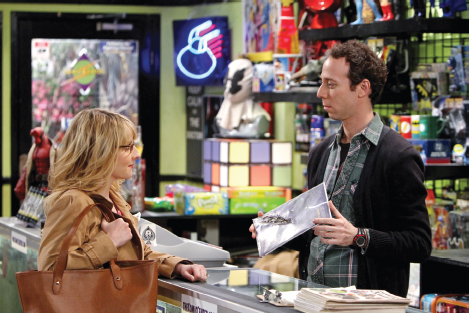The Formation of Cliques
As you learn in Chapter 5, we define ourselves by our group memberships, with a tendency toward favoring our ingroup members and comparing ourselves to (and sometimes excluding) outgroup members. Although it may be a natural tendency to form cliques with those who share our affiliations, competent communicators must remember to be inclusive of various groups and co-cultures—particularly in team and organizational settings.
In the comedy series The Big Bang Theory, geniuses Leonard and Sheldon are roommates and close friends. Sheldon, the quirky theoretical physicist, is extremely socially awkward and rarely takes kindly to new people or situations. Inevitably, when Leonard starts dating their neighbor, Penny, Sheldon has a difficult time adapting to his friend’s new time commitments. In fact, he even winds up trying to trail along on Leonard and Penny’s dates and frequently interrupts them when they wish to enjoy time alone. Even if you’ve never behaved quite like Sheldon, perhaps you’ve felt like he does—you love hanging out with your best friend, but whenever her boyfriend is around, you feel like you might as well be invisible. That’s because your presence has changed the nature of the communication from dyadic to group communication, but the other two people haven’t adjusted their communication behavior. They’ve remained a dyad that leaves you the lone outsider.
As a group’s size increases, small subgroups of individuals often begin to bond together within the group, forming cliques (or coalitions) (Wilmot, 1987). Cliques are a common part of group life—they’re a fixture in middle school and high school. You have your marching band kids, your football players, the art students, and so on. Many people think that they will escape cliques once high school ends, but this is rarely the case. In college, you might form cliques with others in your major, your dorm, or a particular organization. In office settings, members of cliques or coalitions typically sit next to each other in meetings, eat lunch together, share similar opinions, and support one another’s positions.
When cliques take shape in a group, communication becomes more challenging because members are no longer dealing only with other individual members. Rather, they must navigate relationships and figure out how to communicate with entire subgroups. In addition, countercoalitions, in which one subgroup positions itself against another on an issue, can leave anyone who isn’t affiliated with a subgroup in a very awkward position.

STUART FROM The Big Bang Theory wants to be part of the gang, but often ends up feeling ostracized. MONTY BRINTON/CBS/Landov
This tendency for members of groups to organize themselves into coalitions or cliques can have consequences for those who find themselves left out. Social ostracism is the exclusion of a particular group member (or members)—for example, when one clique or coalition limits the amount of information they share with a particular member and exclude him or her from group activities and the decision-making process (Kameda, Ohtsubo, & Takezawa, 1997). Ostracism can also occur in virtual groups, such as online work teams or Facebook friendship networks. In online environments, exclusion may occur through more subtle signals, such as reduced message frequency or an overall lack of responsive communication (Cramton, 1997; Williams, Govan, Croker, Tynan, Cruickshank, & Lam, 2002).
Rejection by one’s peers can lead to anxiety, anger, and sadness, as targets of ostracism feel a decrease in belonging, control, and self-esteem (Williams, 2001; Wittenbaum, Shulman, & Braz, 2010). However, responses to social ostracism vary. Research on gender differences (Williams & Sommer, 1997), for example, has found that females who are ostracized are more likely to compensate, that is, work harder to be part of the group. Males, on the other hand, tend to engage in a practice called social loafing, which we discuss next.
AND YOU?
Question
If you’ve ever been bullied or witnessed bullying, you know that social ostracism can be a powerful—and hurtful—force. But is excluding someone from communication always aggressive or malevolent? Consider situations in which you may have excluded a group member from communication, either in person or online. What were your motives, and how did it affect communication in the group?
If you’ve ever been bullied or witnessed bullying, you know that social ostracism can be a powerful—and hurtful—force. But is excluding someone from communication always aggressive or malevolent? Consider situations in which you may have excluded a group member from communication, either in person or online. What were your motives, and how did it affect communication in the group?
